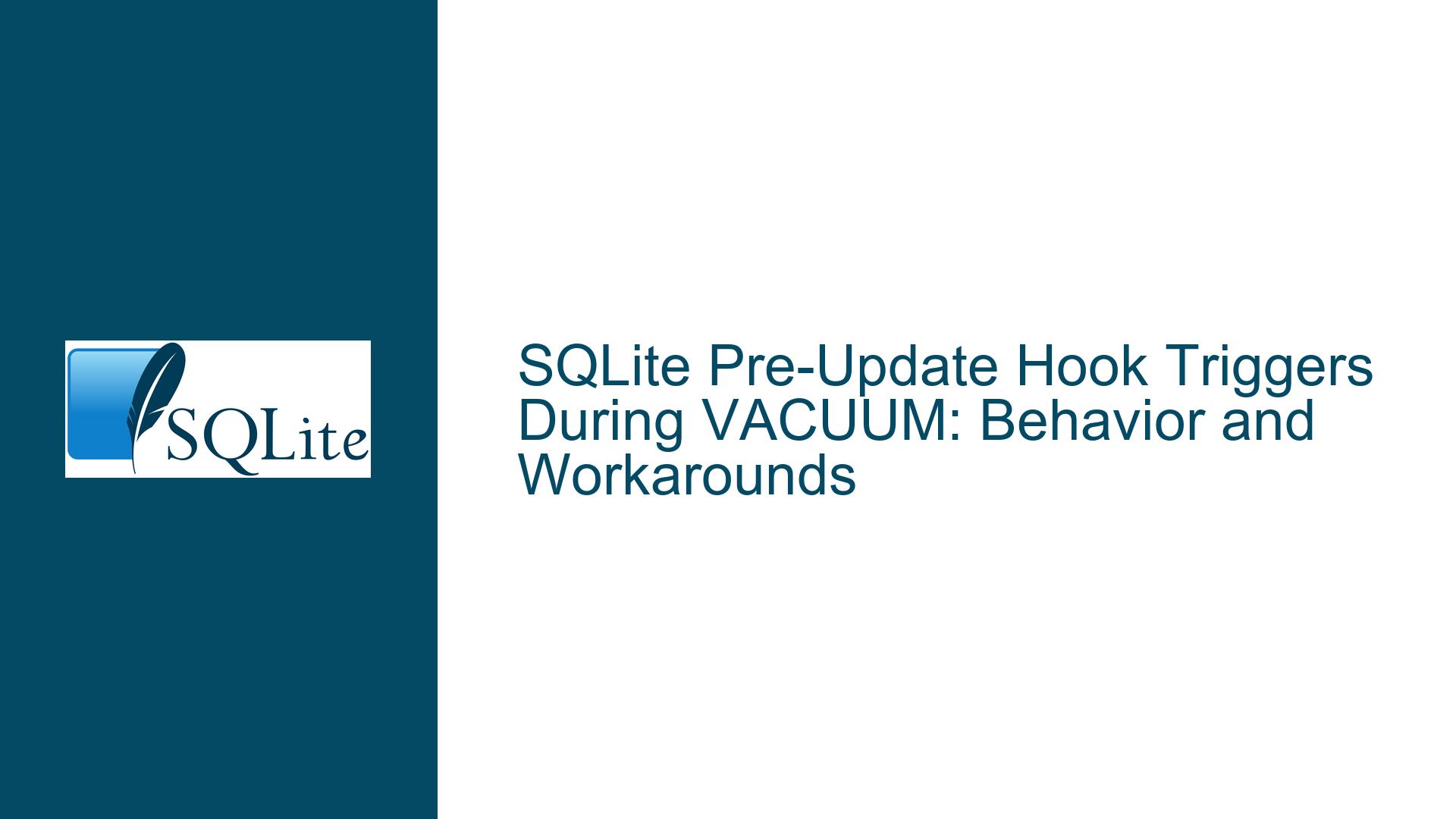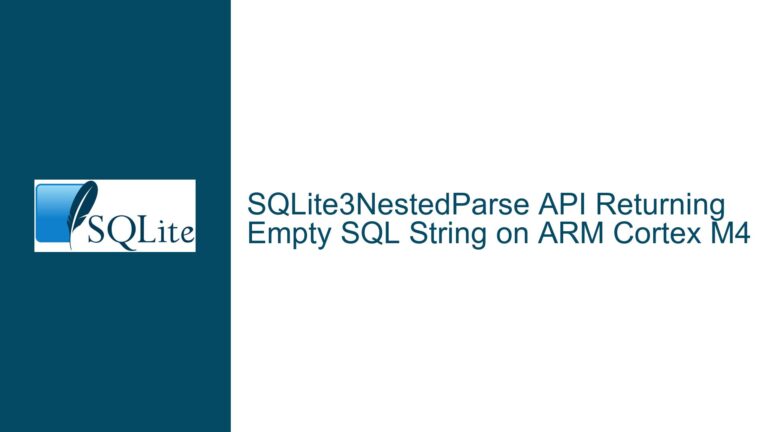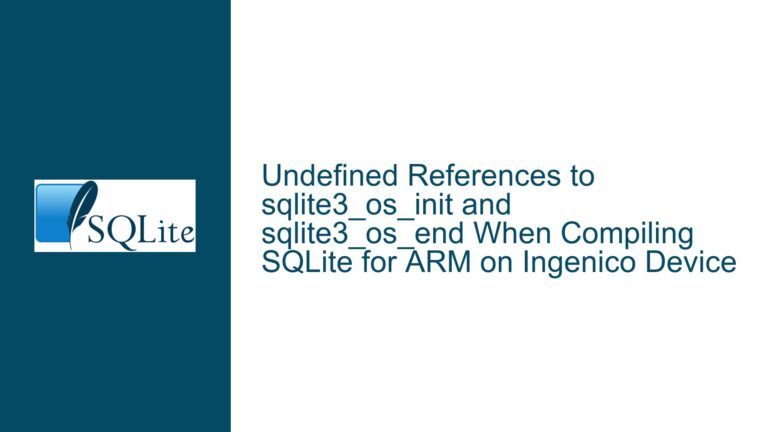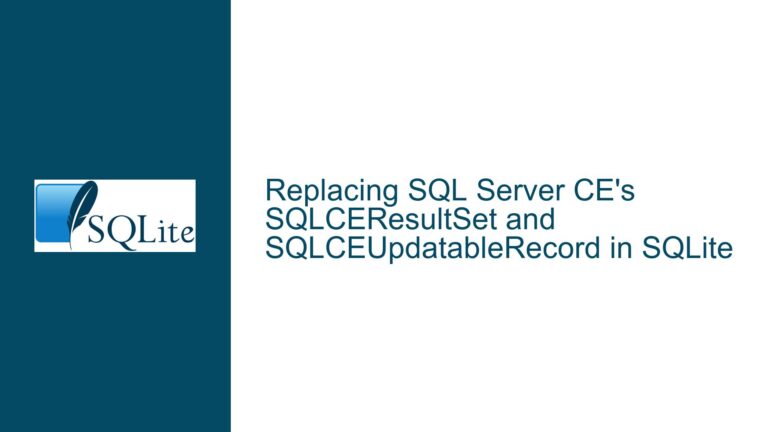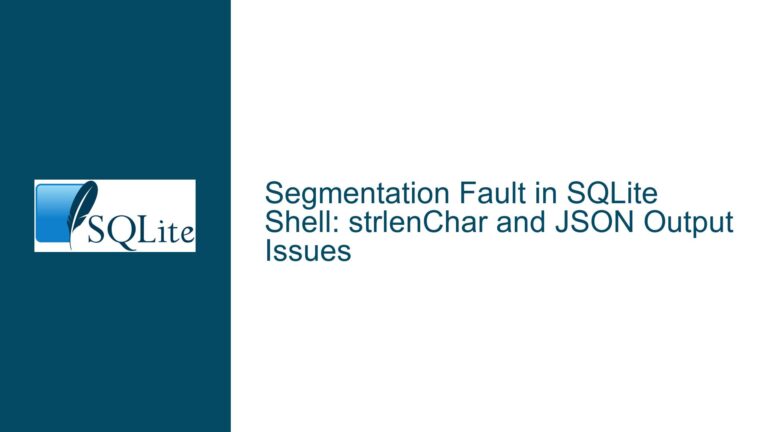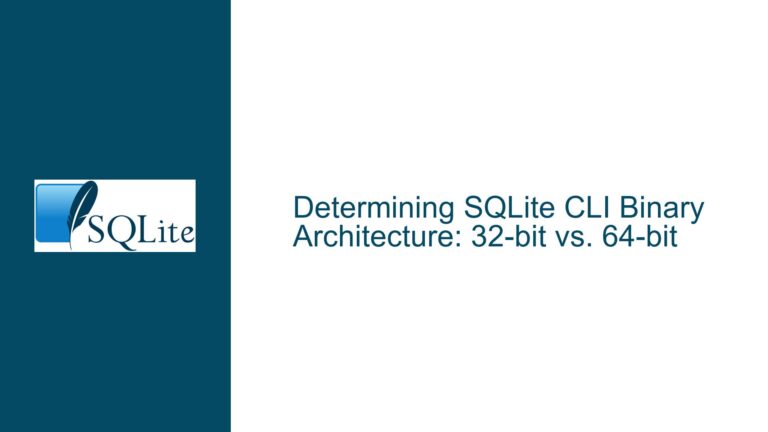SQLite Pre-Update Hook Triggers During VACUUM: Behavior and Workarounds
SQLite Pre-Update Hook Behavior During VACUUM Operations
The SQLite sqlite3_preupdate_hook is a powerful feature that allows developers to register a callback function that is invoked prior to each INSERT, UPDATE, and DELETE operation on a database table. This hook is particularly useful for scenarios where you need to monitor or react to changes in the database at a granular level. However, a nuanced behavior arises when the VACUUM command is executed. The VACUUM command in SQLite is used to rebuild the database file, reclaiming unused space and optimizing the database’s storage structure. During this process, the sqlite3_preupdate_hook callback is triggered for every row that is moved or modified, which can lead to unexpected behavior in applications that rely on this hook.
The core issue lies in the fact that the VACUUM operation can change the rowid values of tables that do not have an INTEGER PRIMARY KEY. This means that even though the VACUUM operation is not a direct INSERT, UPDATE, or DELETE operation from the user’s perspective, it can still result in modifications to the database that are indistinguishable from these operations when observed through the sqlite3_preupdate_hook. This behavior can be problematic for applications that use the hook to track changes, as it may result in a flood of notifications that are not relevant to the actual user-initiated changes.
The documentation for sqlite3_preupdate_hook does not explicitly state that the callback will be invoked during VACUUM operations. This omission can lead to confusion, as developers may not anticipate the hook being triggered during what is essentially a maintenance operation. The behavior is technically correct in the sense that the VACUUM operation does involve modifications to the database, but it is not immediately obvious that these modifications would trigger the pre-update hook.
Interplay Between VACUUM and Rowid Modifications
The VACUUM command in SQLite can lead to changes in the rowid values of tables that do not have an INTEGER PRIMARY KEY. This is because the VACUUM operation rebuilds the database file from scratch, and during this process, the rowid values may be reassigned. For tables with an INTEGER PRIMARY KEY, the rowid is typically the same as the primary key, and thus, it remains unchanged during a VACUUM. However, for tables without an INTEGER PRIMARY KEY, the rowid values can be altered, which can have implications for applications that rely on these values.
The sqlite3_preupdate_hook callback is designed to provide information about the changes that are about to be made to the database. This includes the type of operation (INSERT, UPDATE, or DELETE), the old and new values of the row, and the database and table names. When the VACUUM operation changes the rowid values, the pre-update hook is triggered for each row that is affected. This can result in a significant number of callback invocations, especially for large databases.
The issue is further complicated by the fact that the VACUUM operation is often performed automatically by SQLite or as part of routine database maintenance. This means that the pre-update hook may be triggered at unexpected times, leading to potential performance issues or unintended side effects in applications that use the hook. For example, if the hook is used to maintain an external index or to log changes, the VACUUM operation could result in a large number of unnecessary updates to the index or log.
One potential workaround is to use the zDb parameter of the sqlite3_preupdate_hook to limit the scope of the hook to specific databases. Since the VACUUM operation runs on a temporary database, it is possible to filter out the callback invocations that occur during the VACUUM by checking the database name. However, this approach is somewhat of a hack and may not be suitable for all applications. A more robust solution would be to modify the behavior of the sqlite3_preupdate_hook to explicitly exclude VACUUM operations, or to provide a way for developers to distinguish between VACUUM-induced changes and user-initiated changes.
Implementing Robust Solutions for Pre-Update Hook Behavior
To address the issue of sqlite3_preupdate_hook being triggered during VACUUM operations, several approaches can be considered. The first and most straightforward solution is to modify the documentation to explicitly state that the pre-update hook may be invoked during VACUUM operations. This would help set the correct expectations for developers and prevent confusion.
Another approach is to modify the behavior of the sqlite3_preupdate_hook itself to exclude VACUUM operations. This could be done by adding a flag or parameter to the sqlite3_preupdate_hook function that allows developers to specify whether they want the hook to be invoked during VACUUM operations. This would give developers more control over when the hook is triggered and allow them to avoid unnecessary callback invocations.
A third approach is to provide a way for developers to distinguish between VACUUM-induced changes and user-initiated changes within the pre-update hook callback. This could be done by adding additional information to the callback parameters, such as a flag indicating whether the change is part of a VACUUM operation. This would allow developers to filter out VACUUM-related changes within the callback itself, without needing to modify the behavior of the hook.
In addition to these solutions, it is important for developers to be aware of the potential impact of VACUUM operations on their applications. If the pre-update hook is used to maintain an external index or to log changes, it may be necessary to temporarily disable the hook during VACUUM operations to avoid performance issues. This can be done by unregistering the hook before starting the VACUUM operation and re-registering it afterward.
Finally, developers should consider the design of their database schema and the use of INTEGER PRIMARY KEY to avoid issues with rowid changes during VACUUM operations. By using INTEGER PRIMARY KEY for all tables, developers can ensure that rowid values remain stable during VACUUM operations, reducing the likelihood of unexpected changes and the associated callback invocations.
In conclusion, the behavior of the sqlite3_preupdate_hook during VACUUM operations is a nuanced issue that can have significant implications for applications that rely on this hook. By understanding the interplay between VACUUM and rowid modifications, and by implementing robust solutions to manage the behavior of the pre-update hook, developers can avoid unexpected issues and ensure the smooth operation of their applications.
